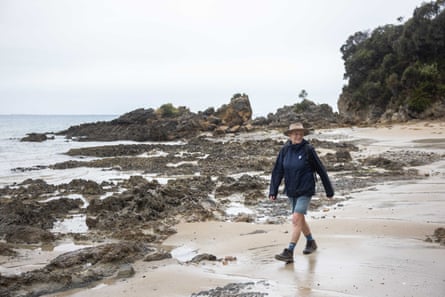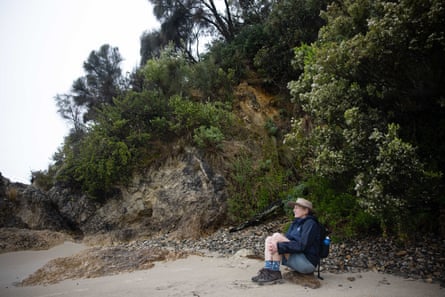
The rain has been pelting down for hours. It’s still bucketing as we set out along a South Gippsland beach, but Alison Lester is intrepid.
“I do love walking,” she says. “I love overnight hiking. I just think it’s the best thing. But I didn’t discover it until I was quite old. When I was younger I never had the right gear and I probably took too many things, but now … I just enjoy heading off for a few days and having everything with me.”
The prolific children’s author grew up on a farm near the Victorian town of Foster, not far from here. The views of the sea nestled between hills, instantly recognisable in her 1992 picture book My Farm, were a fixture of Lester’s early years. She still owns a small piece of that farm, about 150 acres, and splits her time between it, her home in Nar Nar Goon and the tiny town of Fish Creek, where she has a shop.
Today, she’s my guide along the nearby beach from Waratah to Walkerville as the tide slowly creeps out and the rain eases. We’re here for what I will now always think of as Magic Beach – a nook in the coastline at Walkerville South, on which Lester’s classic 1990 picture book of the same name is based.
All through Lester’s life, summers have been spent at Walkerville. One year, her editor came to stay, and suggested Lester turn the beach of her childhood into a book. The original concept, Lester says, was focused on one child’s imagination.
“There’s a little cave that we always take the kids to, you can only get to it at low tide,” Lester says. “It’s called the mermaid’s cave, and it’s got a little doorway and windows. Anyway, I made up a story about a little girl who had been taken out to see the mermaid’s cave and really believed there was a mermaid on her beach.”
Her editor asked if she could make the story broader, and so evolved the collective, poetic voice that welcomes the reader to “our beach, our magic beach”.
Lester was a published illustrator before she was a published writer, and an art teacher before that. She got her first illustrating gig by making a cold call to Oxford University Press, after looking the company up in the phone book. That was in 1979. Her first foray as a writer-illustrator in her own right, Clive Eats Alligators, came out in 1984. “Once I did that one on my own, I thought, ‘This is what I want to do. I want to be in charge of the whole thing’,” she says.
Lester has been writing and illustrating children’s books my entire life – she’s published about 50 of them. The week before our walk, my mother dutifully dug out our small collection: along with My Farm, there’s When Frank Was Four (1994), The Journey Home (1993), Tessa Snaps Snakes (1990), and a particularly well-loved copy of Imagine (1989), its spine cracked, the pages held together by decades-old pieces of disintegrating sticky tape.
Almost all of them had been signed at one of the innumerable talks Lester has done at libraries and primary schools around the country over the years; She still spends much of her time on tour. Her work is so popular and widely loved that in 2011 she was appointed Australia’s first children’s laureate.

Imagine is the book that seems most central to her ethos. Two children (and their possibly reluctant cat) play at making other worlds out of everyday items: a draught-stopper becomes a snake coiled around a jungle branch; a kitchen strainer is a deep-sea fishing net. Over the page, their imaginary world appears in full colour – they are riding dolphins, cuddling leopards, leading huskies across the ice.
Lester’s artistic style is disarming: cheerful watercolours and simple lines, through which shines a keen eye for expression, detail and the joyful mess in the daily life of children and animals. She was an outdoorsy child herself, and credits long days rambling around with her pony as the wellspring of her own creative freedom. She wonders how children now find the space to let their creativity unfurl.
“Part of it is having time just to daydream,” Lester says. “It’s important to get off the screens for long enough to let that happen. If every minute of every day is filled with a game or watching something or doing something, there’s no time to let your mind wander, no time to just be in the world.”
She says this thoughtfully, without judgement. She has her own time-sucking habits; sometimes, she says, she spends hours just scrolling through real estate listings, looking at houses she has no interest in or ability to buy.
In the post-rain quiet, our boots crunch across mounds of tiny shells washed up out of a now-tempered surf – a treasure trove of delicate, discarded remnants of underwater life. I pluck a small starfish out of one of these and Lester tells me I’ve just discovered “high-value beach currency”: “That’s a biscuit star. Keep that one. When you wash the sand off it, it will be exquisite. It might stink for a little while but it will be really beautiful.”
Lester’s adventurousness extends beyond being a tenacious hiker. She’s been to Antarctica multiple times, beginning with an arts fellowship in 2005, the success of which led to opportunities as a resident artist on tourist ships, inspiring her to create the picture books Sophie Scott Goes South (2012) and One Small Island (2011, with Coral Tulloch).
Lester’s current project is also about Antarctica – another collaboration with Coral Tulloch that brings together poetry, prose and drawings.
“I don’t think about Antarctica all the time but I don’t think I’ll ever stop being inspired by it,” she says. “I think living so close to it, it always felt incredible, and I just love those adventure stories about it.”
She stops to exclaim at the beauty of the sea – flat like glass, reflecting the steely colour of the clouds, and everything but us and the occasional forest bird utterly still.

We approach Walkerville South, where old lime kilns loom over a flat sandy beach, crumbling stone and brick giants of another century, the bush encroaching on them, trees growing up through the ruins. Lester points to a piece of wood sticking vertically out of the sand – the last remnant of the huge jetty that was part of the lime works.
As we get closer, Lester points out her “spot”, the place she likes to sit under the shadow of the rock. Superb fairywrens flit about under the boulders.
Last summer, they put the youngest baby, Lester’s granddaughter Goldie, down for a nap under one of the bushes, “and the wrens would all hop around her while she was sleeping,” Lester says. “It’s a really lovely place.”
In the serene aftermath of the storms, the beach stretching out before us, it truly feels like a place of wonder and enchantment.


